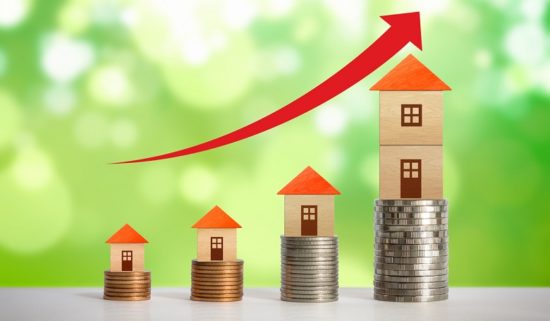Long-Term Mortgage Rates Hit a Seven-Year High
It Will Cost You More to Buy a Home

Rates crossed the 4 percent threshold in the week of January 11 and they have been on a relatively steady rise since then. If this pace continues, we may hit 5 percent before the year is out.
Should rising interest rates deter you from buying a home? Not necessarily, but it may cause you to re-think your definition of an affordable home.
How Much More?
To see the effect of higher interest rates, consider this example. Let’s assume you’re buying a $200,000 house with a 20 percent down payment.
Your monthly principal and interest payment will be $764 at 4 percent interest, $821 at the current 4.61 percent, and $859 at 5 percent.
For the $160,000 you are borrowing, the difference between 4 percent and 5 percent amounts to over $34,000 in extra interest charges over the life of the loan.
With a lower down payment, the difference is even larger. Cut the down payment to 10 percent in the above scenario and the difference in interest charges grows to over $38,000 on the $180,000 you are now borrowing.
It Could Be Worse
While thirty-year fixed mortgage rates have hit their highest point in seven years, a little perspective is in order.
It’s difficult to overemphasize how much the housing crisis and the steps to save the post-crisis economy affected interest rates.
Since May 6 of 2010, there has only been one week with thirty-year fixed interest rates ending over 5 percent – February 10, 2011 at 5.05 percent.
More Historical Context
In the 38 years prior to the beginning of 2009, interest rates had never been below 5 percent. Rates were in double digits for the majority of the 1980s.
Using our $200,000 mortgage with 20 percent down example, at 10 percent interest, the monthly payments are a whopping $1,404.
Compared to current rates, you would pay over 2.5 times as much in interest charges.
Parents and grandparents who bought homes in the 1980s probably don’t have much sympathy for your complaints about a mortgage rate of 5 percent.
Are we reaching a threshold that could lead to another thirty-plus year of rates over 5 percent? Perhaps – but that just makes wise financial management even more important.
You Can Overcome
When interest rates are rising, it’s important to keep your financial house in order to get the lowest rate possible – whatever that rate happens to be at the time.
If you don’t know your credit score, start there. A recent analysis by Zillow found that a borrower applying for a loan on a $213,100 home (the current median price) with a 20 percent down payment would qualify for a 4.5 percent rate with a credit score above 760.
With a fair credit score of 640-679, the same borrower would only qualify for a 5.1 percent interest rate. In this case, the difference in credit score equates to an extra $21,000 in cost over the life of the loan.
Review Your Score
Review your score well before you search for a mortgage – six months is preferred. That allows time to correct errors in your report or make changes in your finances that improve your score.
If you already have a significant debt load – especially credit card balances – adjust your budget to create a monthly surplus and use that surplus to pay down your debt.
Budget well in advance to build up a suitable down payment – 20 percent is the standard. You may qualify for loans with lower down payments, but you’ll pay significantly more in interest over a full thirty-year loan, and private mortgage insurance (PMI) may be required.
How Much Can You Afford?
Once you’ve done everything you can to get a good rate, the next step is to calculate how much you can afford to make in monthly payments, taking into account taxes, insurance, homeowners association fees, and maintenance costs.
“In terms of the monthly payments for your mortgage – and this is going to include the taxes and insurance… you don’t want that to exceed more than 28 percent of your gross monthly income,” recommends Bankrate.com Senior Vice President and Chief Financial Analyst Greg McBride.
Then search for homes in that price range – which is where you’ll run into the next problem.
Interest Rates Aren’t the Only Issue
Thanks to a low supply of homes and increasing demand – especially for starter homes – it’s going to be difficult to find value.
Bidding wars for homes are not uncommon, and it’s possible for first-time homebuyers to be priced out of the market.
Don’t fall into temptation and buy more home than you can afford. Even with tight credit, you may find a lender that will loan you more than your financial situation suggests that you should borrow.
If you really want a more expensive home, adjust your budget even further to gain the funds you need – and include the likelihood of even higher interest rates in your plans.
The Takeaway
America has been on an unusually long run of low-interest rates. There’s no question that you’ll pay more for the same home if interest rates rise – but that’s just one factor in a long list of considerations when you’re ready to enter the housing market.
You can’t control the actions of the Federal Reserve, but you can control your loan qualifications.
Planning, diligence, and a bit of lender shopping can earn you the best interest rates possible. After that, it’s up to you to find the best home value to go along with that superior rate.
This article was provided by our partners at moneytips.com. Photo ©iStockphoto.com/suwichaw
If you enjoy reading our blog posts and would like to try your hand at blogging, click here to get started.
